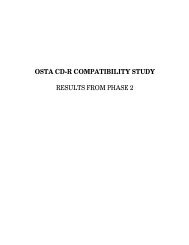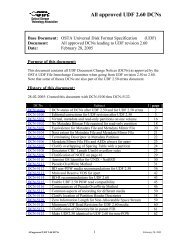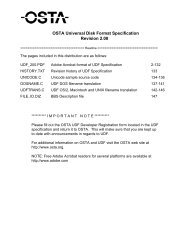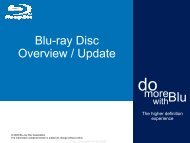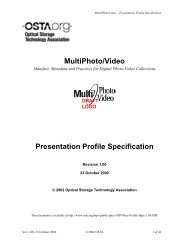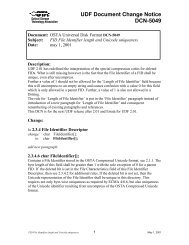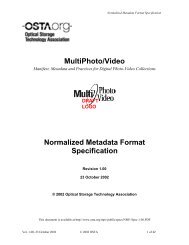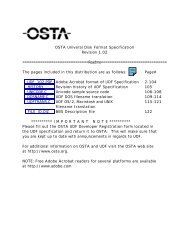here - OSTA - Optical Storage Technology Association
here - OSTA - Optical Storage Technology Association
here - OSTA - Optical Storage Technology Association
You also want an ePaper? Increase the reach of your titles
YUMPU automatically turns print PDFs into web optimized ePapers that Google loves.
Non-UDF<br />
Application Use<br />
Extended Attribute<br />
UDF Unique ID<br />
Mapping Data<br />
Power Calibration<br />
Table Stream<br />
Logical Volume<br />
Integrity Descriptor<br />
Application ID “*Application ID” Application Identifier<br />
Suffix<br />
Implementation ID “*Developer ID” Implementation<br />
Identifier Suffix<br />
Implementation ID “*Developer ID” Implementation<br />
Identifier Suffix<br />
Implementation ID “*Developer ID” Implementation<br />
(in Implementation<br />
Identifier Suffix<br />
Use field)<br />
Implementation ID N/A N/A<br />
Partition Integrity<br />
Entry<br />
Virtual Partition Map Partition Type “*UDF Virtual UDF Identifier Suffix<br />
Identifier<br />
Partition”<br />
Virtual Allocation Implementation Use “*Developer ID” Implementation<br />
Table<br />
Identifier Suffix<br />
(optional)<br />
Sparable Partition Partition Type “*UDF Sparable UDF Identifier Suffix<br />
Map<br />
Identifier<br />
Partition”<br />
Sparing Table Sparing Identifier “*UDF Sparing UDF Identifier Suffix<br />
Table”<br />
Metadata Partition Partition Type “*UDF Metadata UDF Identifier Suffix<br />
Map<br />
Identifier<br />
Partition”<br />
NOTE: The value of the Entity Identifier field is interpreted as a sequence of<br />
bytes, and not as a dstring specified in CS0. For ease of use the values used by<br />
UDF for this field are specified in terms of ASCII character strings. The actual<br />
sequence of bytes used for the Entity Identifiers defined by UDF are specified in<br />
section 6.2.<br />
NOTE: In the ID Value column in the above table “*Application ID” refers to an<br />
identifier that uniquely identifies the writer’s application.<br />
In the ID Value column in the above table “*Developer ID” refers to an Entity Identifier<br />
that uniquely identifies the current implementation. The value specified should be used<br />
when a new descriptor is created. Also, the value specified should be used for an existing<br />
descriptor when anything within the scope of the specified EntityID field is modified.<br />
NOTE: The value chosen for a “*Developer ID” should contain enough<br />
information to identify the company and product name for an implementation.<br />
For example, a company called XYZ with a UDF product called DataOne might<br />
choose “*XYZ DataOne” as their developer ID. Also in the suffix of their<br />
developer ID they may choose to record the current version number of their<br />
DataOne product. This information is extremely helpful when trying to determine<br />
which implementation wrote a bad structure on a piece of media when multiple<br />
products from different companies have been recording on the media.<br />
UDF 2.01<br />
16<br />
March50 April



